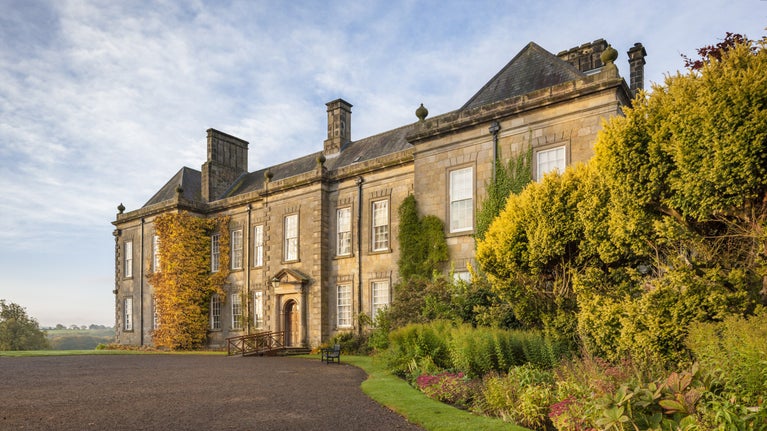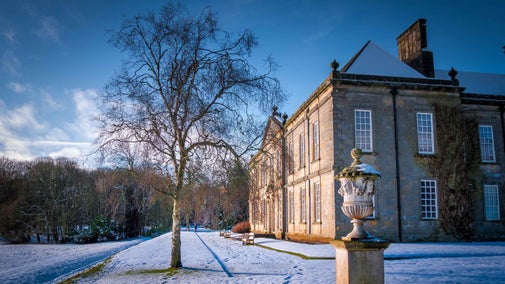
Discover more at Wallington
Find out when Wallington is open, how to get here, the things to see and do and more.

In November 2020, Wallington was successful in its bid for funding from the DEFRA Green Recovery Challenge Fund. The aim of the fund is to support projects that are ready to focus on and deliver nature-based solutions and restoration and connect people with nature. Find out more about how Wallington benefited from the fund, including some fascinating archaeological discoveries unearthed by ‘LiDAR’ technology.
The Green Recovery Challenge Fund is a competitive short-term fund to kickstart the process of nature recovery, address the climate crisis and help create and retain thousands of green jobs.
The £40 million fund has been developed by Defra and its arm’s-length bodies, including Natural England, Forestry Commission and Environment Agency. The National Lottery Heritage Fund is distributing and monitoring this government money.
The 'Historic Landscapes' programme has been awarded £3.85 million by Defra as part of the Green Recovery Challenge Fund. The funding will kickstart a programme of work, worth over £4.7 million, to enhance nature and combat the effects of climate change in five of the most significant historic landscapes in our care.
Through the Historic Landscapes programme, Wallington has benefited from over £800,000 of funding. Centred in the Hart Burn Catchment, these vital funds have allowed us to undertake major river enhancements works including fencing and significant hedgerow and woodland creation, enabling habitat and species restoration.
The work will see significant habitat gains, leading to increased nature connectivity and enhanced environmental farming practices. With this fund, over the last year we have planted 10.1km of hedgerows and 75,000 trees and restore 50km of waterways along the river corridors that will enable natural processes to prevail.
The ambition over the next 50 years, is to work with our partners to create rich and healthy spaces for nature, and in doing so reverse the decline in wildlife and their habitats. We are working to create places where people and nature can thrive together.
We’ll also be widening access to different parts of the estate – whether you’re walking or cycling – with a new network of routes. We’re excited to see the positive impact this will have on the health and wellbeing of all our visitors, as well as the local community.
Through the Green Recovery Challenge Fund, we were pleased to welcome two apprentice Rangers – Rosie and Nick – who joined the Wallington team back in March 2021. You may well see them on your visit, so do stop to say hello. Groups at the West End Refugee Service have also been learning about woodland management and how to identify the species that live at Wallington.
Since Wallington came into our care, we've worked to restore damage caused by intensive land management and the increased demand for forestry and food production, which have affected biodiversity, reduced water quality and degraded peat soils. These problems have been magnified by the climate crisis and these precious habitats have little resilience to adapt to extreme weather.
In November 2021, Wallington's tree population was devastated by Storm Arwen. Winds of up to 98mph tore through the region and destroyed 40 hectares of trees. Among those lost were a 250-year-old oak, beech trees planted by Walter Calverley Blackett (who bought Wallington in 1688) and larch trees given to the estate in 1738 by the Duke of Atholl.
We're working with the Great Northumberland Forest project, run by Northumberland County Council, to replace lost trees and save veteran trees for future generations. To date, 75,000 trees have been planted, creating 12 hectares of new deciduous woodland and more than 10km of hedgerow. Peat bogs, which lock in carbon, are also being restored.

It's always been a wish to use LiDAR (Light Detection and Ranging) to survey this huge estate and in February 2021 we commissioned Blue Sky International Ltd to do just that.
As the biggest LiDAR survey conducted by the National Trust to date, across 57 square kilometres of the 5,431 hectare estate, we were hopeful for some useful insights into where to fulfil our huge planting ambitions as well as some exciting archaeological discoveries. We weren’t disappointed.
The LiDAR technology provided fascinating insights into farming practices and other archaeological aspects of the landscape dating back to 2,000 BC, while locating new areas for tree planting, hedgerow creation and river management.
LiDAR uses the pulse from a laser to collect precise measurements between a light aircraft as it flies over the landscape and the ground, to produce a minutely detailed map of the ground surface.
The results are so detailed that they can reveal features that are not readily discernible to the naked eye, allowing researchers to penetrate vegetation cover to identify features concealed by trees and undergrowth. It can also be used to map ecological features like water courses.
The initial analysis, concentrated on the area where the majority of the new trees are to be planted, has revealed fascinating details of Wallington’s archaeology dating from 2,000 BC to 1,900 AD, including traces of historic, healthy woodlands dating from the mid-18th century, which were cleared and not replanted.

This information has helped the team make critical decisions on where new trees, hedgerows, fences and site access points should go, to minimise the impact on the landscape’s archaeology. By basing new planting plans on historic planting schemes, the team also aims to create even more habitat benefit as well as restoring lost features of the historic environment.
Over 120 new archaeological features have been discovered, covering more than 85% of the ground surface in some areas. Findings of particular interest include early farming systems, which were cast aside in the 18th century by previous owner Sir Walter Blackett’s desire to make way for “rational” and efficient farming.
These include at least half a dozen different forms of ‘ridge and furrow’ cultivation, which together with the estate’s documentary record will help with dating other features in the landscape such as the field boundaries – the Northumberland ‘cast’ field banks – stonewalled to each side.
Previously recognised Iron Age ‘camps’, like mini-hillforts, estimated as dating from the centuries immediately prior to the Roman invasion, have been surveyed with greater precision to reveal more eroded outlying features, possible annexes to the main enclosures, and even suspected prehistoric pathways.
Analysing all the survey results has taken a lot of time, but with each hour spent studying them we’re finding out more and more about the past of this vast estate and, importantly, using it to determine the future plans for large landscape-scale nature recovery.
Climate change, extreme weather and historic farming have taken their toll on Wallington's diverse and varied landscape. Wildlife and trees have been badly affected but with the help of funders and partners we're working to restore the damage. Watch this video to find out more.

Find out when Wallington is open, how to get here, the things to see and do and more.

We've partnered with the Great Northumberland Forest project, run by Northumberland County Council, to replace lost trees and save veteran trees for future generations.
Find out more about our significant conservation project aimed at protecting the native white-clawed crayfish, now classified as endangered and at risk of extinction.

Learn about the important work we‘ve carried out in recent years, from restoring the clocktower to commissioning some modern art and introducing the tree donation scheme.

Discover how key members of the Blackett family were instrumental in remodelling the Wallington Estate into the house and grounds we know today.

The wider estate at Wallington has several cattle and sheep farms. Read our guide to staying safe around the animals when you’re walking along the estate's footpaths and trails.

There's lots to keep the family entertained at Wallington, whatever the season. Look out for wildlife on the River Walk, zoom along the Dragon cycle trail or go wild in one of the play areas (play train currently closed). Don't forget our impressive selection of splashy puddles on soggy days; we've got the mud if you've got the wellies! For rumbling tummies, why not make a stop at the Clocktower Café or one of our kiosks?
